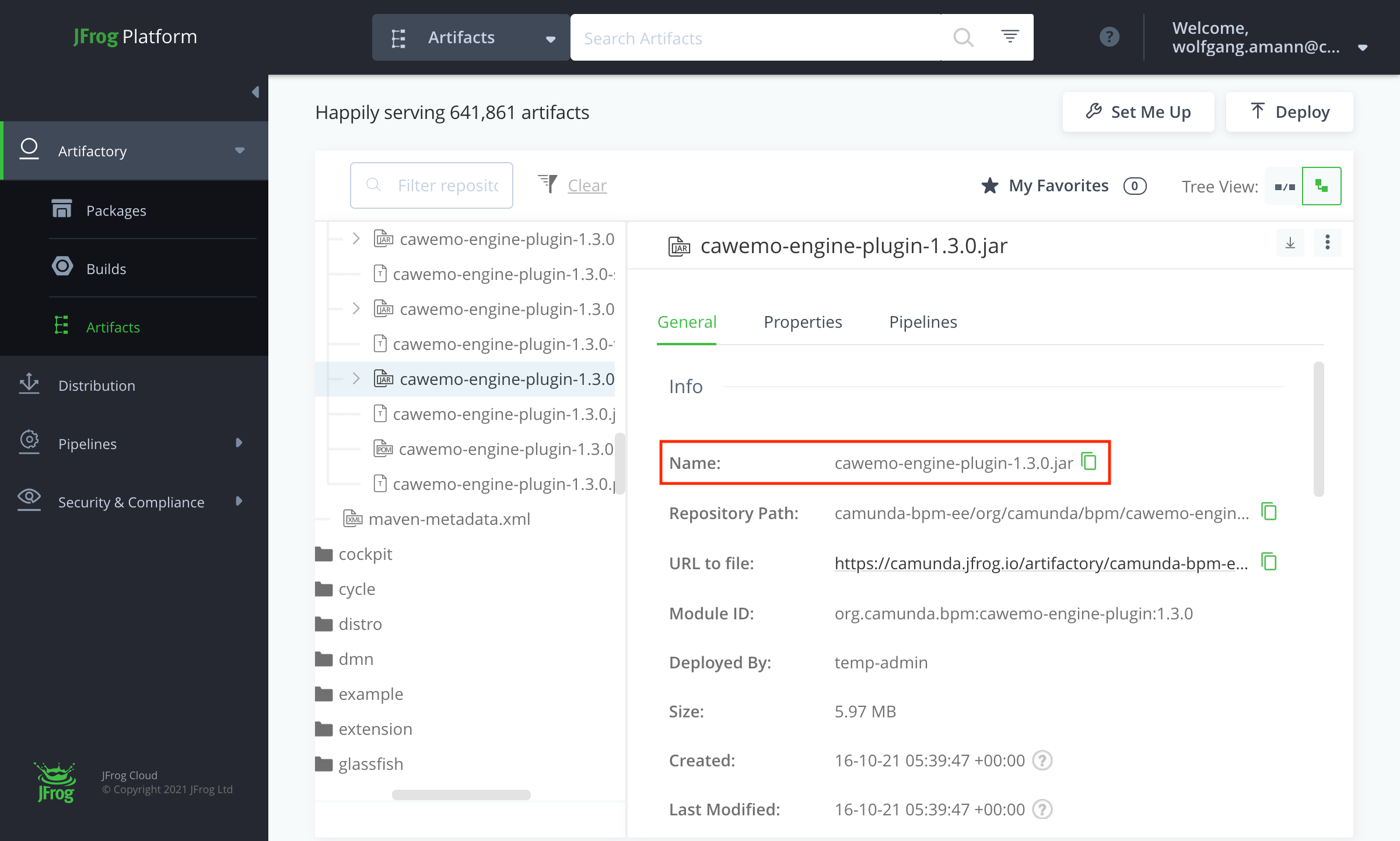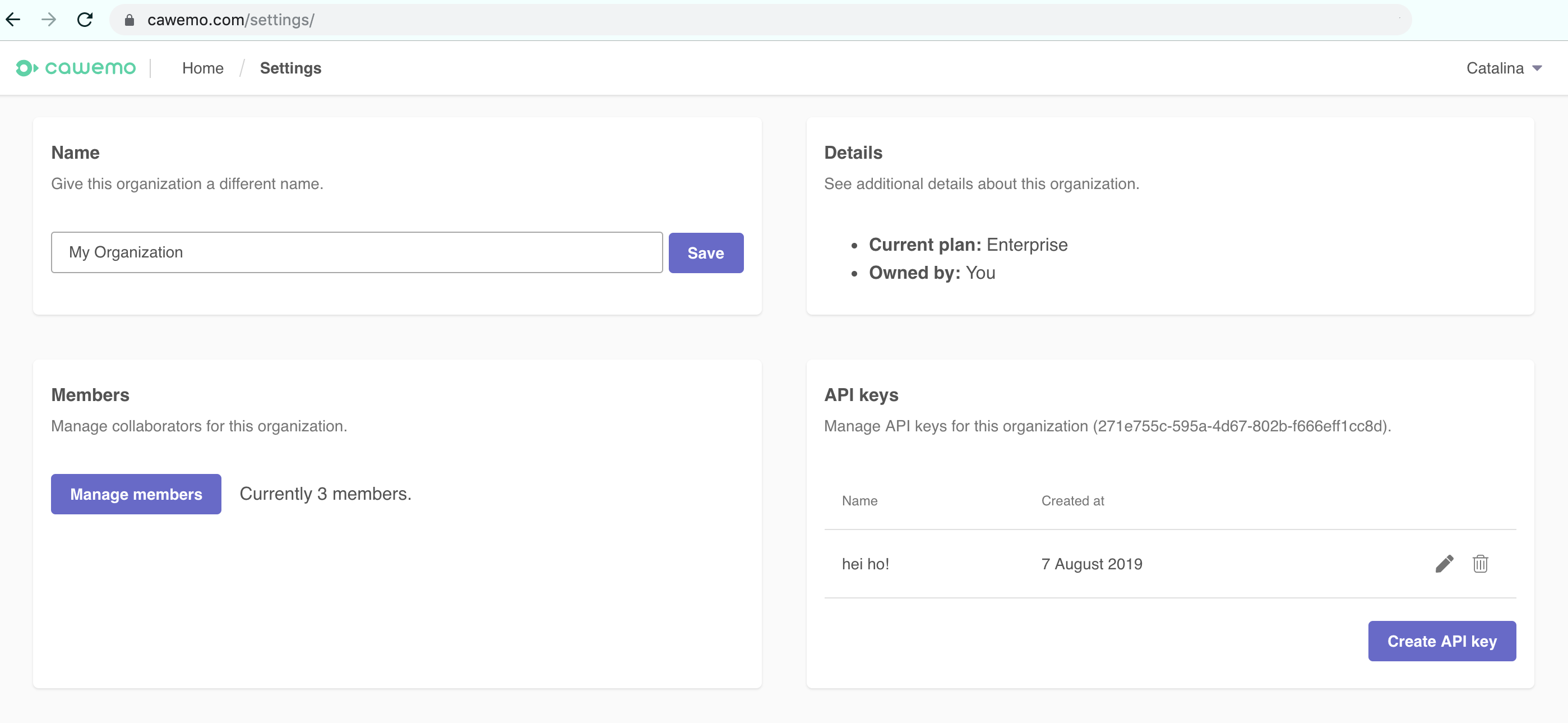Camunda Platform Engine
Cawemo Engine Plugin Retirement
The Cawemo Engine Plugin was retired effective 19th February 2025 and is no longer maintained. For more details and alternatives, please refer to the retirement announcement in the Camunda forum.
This plugin offers a link between a Camunda Platform Process Engine and a Cawemo instance. It syncs all deployed process definitions to the configured Cawemo account. The synced diagrams will be added to a special project with the name as configured in the plugin.
Installation
Note: If you’re using Camunda Platform’s stand-alone application servers skip this section and download the dependency as a JAR as described below.
The latest version of this plugin is 1.3.0 and can be installed either as a Maven dependency or as a JAR file.
As Maven Dependency
The simplest way to install this plugin is by adding a dependency to your pom.xml:
<dependency>
<groupId>org.camunda.bpm</groupId>
<artifactId>cawemo-engine-plugin</artifactId>
<version>1.3.0</version>
</dependency>
As JAR
Alternatively, you can also add the JAR to your classpath. To get the JAR, you should:
- Go to JFrog Artifactory and login with your credentials.
- Go to Artifacts/camunda-bpm-ee/org/camunda/bpm/cawemo-engine-plugin
- Download
cawemo-engine-plugin-1.3.0.jar

Or use this link that will prompt you to download if you are already logged in with the right credentials.
Configuration
1. Generate an API Key via Cawemo
Log in to your target Cawemo instance and create an API key from your organization settings.

To learn more about best practices regarding API keys please visit our user guide.
2. Extend Your Camunda Process Engine Configuration
Add the following section to your process engine configuration and replace the placeholders with actual values (see below for the location of the configuration depending on your application server):
<plugin>
<class>org.camunda.cawemo.plugin.CawemoEnginePlugin</class>
<properties>
<property name="cawemoUrl">https://cawemo.example.com</property>
<property name="userId">change-me</property>
<property name="apiKey">change-me</property>
<property name="projectName">change-me</property>
<property name="authMode">BASIC</property> <!-- or QUERY_PARAM -->
<property name="customBasicAuth">false</property>
</properties>
</plugin>
Parameters Explained
cawemoUrl: Your target Cawemo instance, e. g. https://cawemo.example.comuserId: The corresponding userId of the API key used for authentication.apiKey: A valid API key associated with your userId, created as described above.projectName: The name of the engine the pushed diagrams should be linked to. This property affects the name of the project in which the diagrams will be stored, e.g. “projectName Deployments”.If you’re running Camunda Platform in a cluster setup this property’s value should be the same on all nodes.
The
authModeconfiguration parameter determines how the Cawemo Engine Plugin authenticates with the target Cawemo instance:BASIClets the plugin use basic access authentication via anAuthorizationheader field passed with each request.- When choosing
QUERY_PARAMthe engine plugin appends the required credentials as query parameter to the request URL.
It is strongly advised to use the
BASICoption and only use query parameter authentication as a fallback solution.customBasicAuthlets you add a basic auth header on top of the query parameter authentication. Cannot be combined with theBASICoption ofauthMode. If you set this option totrueyou’ll have to specify a user via a parameter namedcustomBasicAuthUserand a password viacustomBasicAuthPassword.
3. Specifics for Supported Stand-Alone Application Servers/Spring Boot
JBoss AS/Wildfly
Open the standalone.xml of your application server, look for the <plugins> section and add the configuration stated
above.
Additionally, you have to add the plugin as a module. For this, copy the JAR to
$SERVER_HOME/modules/org/camunda/bpm/cawemo-engine-plugin/main and add a file called module.xml with the following
content to the same folder:
<?xml version="1.0" encoding="UTF-8"?>
<module xmlns="urn:jboss:module:1.0" name="org.camunda.bpm.cawemo-engine-plugin">
<resources>
<resource-root path="cawemo-engine-plugin-1.3.0.jar" />
</resources>
<dependencies>
<module name="org.camunda.bpm.camunda-engine" />
<module name="org.camunda.bpm.model.camunda-bpmn-model" />
<module name="org.camunda.commons.camunda-commons-logging" />
</dependencies>
</module>
As a last step you have to register the plugin. For this, add the following line to
$SERVER_HOME/modules/org/camunda/bpm/camunda-engine-plugins/main/module.xml inside the <dependencies> tag:
<module name="org.camunda.bpm.cawemo-engine-plugin" export="true" />
Attention: If you’re using the pre-packaged JBoss/Wildfly distribution there are two modules folders. The correct
one is located below $CAMUNDA_HOME/server/$SERVER_VERSION/.
For general information about the JBoss/Wildfly configuration see the Camunda Platform documentation.
Tomcat, IBM WebSphere & Oracle WebLogic
Open the bpm-platform.xml of the application server instance your Process Engine is running on, look for the
<plugins> section and add the configuration stated above.
Additionally, you have to copy the plugin JAR to $SERVER_HOME/lib.
Attention: If you’re using the pre-packaged Tomcat distribution there are two lib folders. The correct one is
located below $CAMUNDA_HOME/server/$SERVER_VERSION/.
For general information about the configuration via Camunda Platform Deployment Descriptors see Camunda Platform documentation.
Spring Boot
If you’re using Java configuration you have to register the engine plugin as a bean:
@Bean
@Order(Ordering.DEFAULT_ORDER + 1)
public static ProcessEnginePlugin cawemoEnginePlugin() {
CawemoEnginePlugin plugin = new CawemoEnginePlugin();
plugin.setCawemoUrl("https://cawemo.example.com");
plugin.setUserId("change-me");
plugin.setApiKey("change-me");
plugin.setProjectName("change-me");
plugin.setAuthMode("BASIC"); // or "QUERY_PARAM"
plugin.setCustomBasicAuth(false);
return plugin;
}
If you’re using Spring XML config, open the XML file and add the configuration stated above.
If you want to install the plugin via a JAR you can use it’s -Dloader.path option (see
the Spring Boot documentation).
For general information about the configuration via Spring XML see the Camunda Platform documentation.
Compatibility
| Cawemo | Cawemo Engine Plugin | Camunda Platform Engine |
|---|---|---|
| 1.9 | 1.3.x or newer | 7.20.x or newer |
| 1.8 | 1.1.x or newer | 7.13.x - 7.16.x |
| 1.7 | 1.1.x or newer | 7.13.x - 7.15.x |
| 1.6 | 1.1.x | 7.12.x - 7.15.x |
| 1.5 | 1.1.x | 7.12.x - 7.14.x |
| 1.4 | 1.1.x | 7.11.x - 7.14.x |
| 1.3 | 1.1.x | 7.10.x - 7.13.x |
| 1.2 | 1.1.x | 7.10.x - 7.13.x |
| 1.1 | 1.1.x | 7.9.x - 7.12.x |
| 1.0 | 1.0 | 7.9.x - 7.12.x |
Note
This plugin might have an impact on a process engine’s performance when you’re synchronizing process definitions possessing a lot of versions that are not available on Cawemo as milestones yet. For each of these missing versions the plugin performs a ProcessDefinitionQuery causing the definition to be loaded into the engine’s cache and potentially replacing others which should preferably be retained in the cache.